状语从句讲解
- 格式:ppt
- 大小:281.50 KB
- 文档页数:46
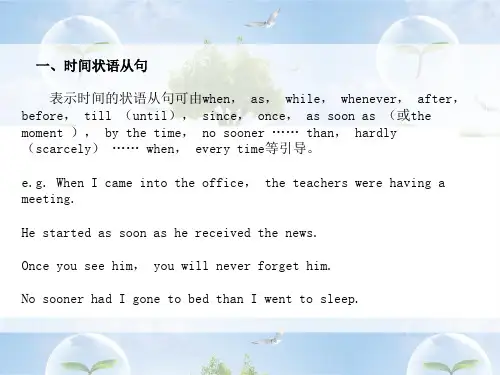
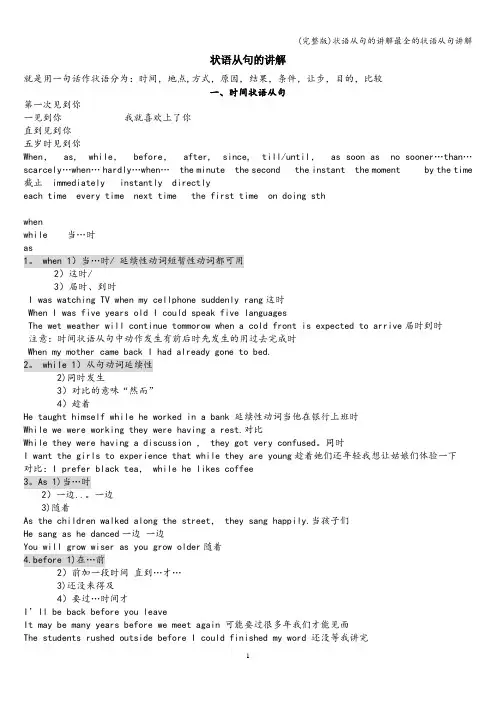
状语从句的讲解就是用一句话作状语分为:时间,地点,方式,原因,结果,条件,让步,目的,比较一、时间状语从句第一次见到你一见到你我就喜欢上了你直到见到你五岁时见到你When, as, while, before, after, since, till/until, as soon as no sooner…than…scarcely…when…hardly…when… the minute the second the instant the moment by the time 截止 immediately instantly directlyeach time every time next time the first time on doing sthwhenwhile 当…时as1。
when 1)当…时/ 延续性动词短暂性动词都可用2)这时/3)届时、到时I was watching TV when my cellphone suddenly rang这时When I was five years old I could speak five languagesThe wet weather will continue tommorow when a cold front is expected to arrive届时到时注意:时间状语从句中动作发生有前后时先发生的用过去完成时When my mother came back I had already gone to bed.2。
while 1)从句动词延续性2)同时发生3)对比的意味“然而”4)趁着He taught himself while he worked in a bank 延续性动词当他在银行上班时While we were working they were having a rest.对比While they were having a discussion , they got very confused。
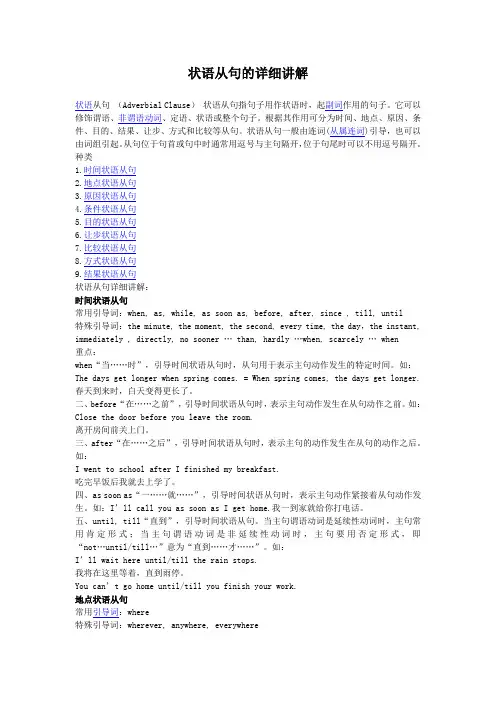
状语从句的详细讲解状语从句(Adverbial Clause)状语从句指句子用作状语时,起副词作用的句子。
它可以修饰谓语、非谓语动词、定语、状语或整个句子。
根据其作用可分为时间、地点、原因、条件、目的、结果、让步、方式和比较等从句。
状语从句一般由连词(从属连词)引导,也可以由词组引起。
从句位于句首或句中时通常用逗号与主句隔开,位于句尾时可以不用逗号隔开。
种类1.时间状语从句2.地点状语从句3.原因状语从句4.条件状语从句5.目的状语从句6.让步状语从句7.比较状语从句8.方式状语从句9.结果状语从句状语从句详细讲解:时间状语从句常用引导词:when, as, while, as soon as, before, after, since , till, until特殊引导词:the minute, the moment, the second, every time, the day,the instant, immediately , directly, no sooner … than, hardly …when, scarcely … when重点:when“当……时”,引导时间状语从句时,从句用于表示主句动作发生的特定时间。
如:The days get longer when spring comes. = When spring comes, the days get longer. 春天到来时,白天变得更长了。
二、before“在……之前”,引导时间状语从句时,表示主句动作发生在从句动作之前。
如:Close the door before you leave the room.离开房间前关上门。
三、after“在……之后”,引导时间状语从句时,表示主句的动作发生在从句的动作之后。
如:I went to school after I finished my breakfast.吃完早饭后我就去上学了。
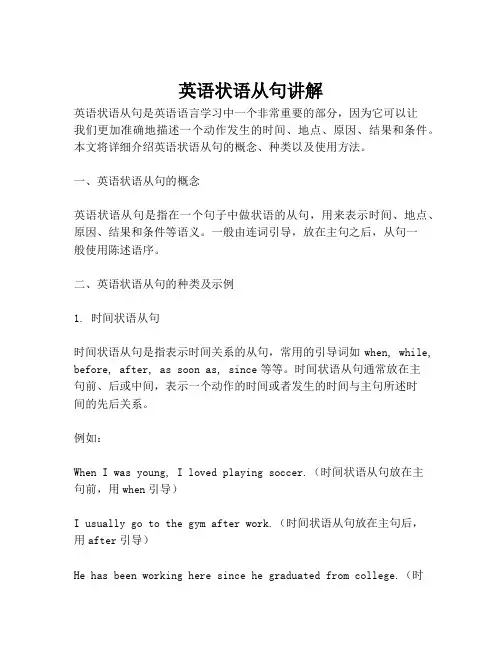
英语状语从句讲解英语状语从句是英语语言学习中一个非常重要的部分,因为它可以让我们更加准确地描述一个动作发生的时间、地点、原因、结果和条件。
本文将详细介绍英语状语从句的概念、种类以及使用方法。
一、英语状语从句的概念英语状语从句是指在一个句子中做状语的从句,用来表示时间、地点、原因、结果和条件等语义。
一般由连词引导,放在主句之后,从句一般使用陈述语序。
二、英语状语从句的种类及示例1. 时间状语从句时间状语从句是指表示时间关系的从句,常用的引导词如when, while, before, after, as soon as, since等等。
时间状语从句通常放在主句前、后或中间,表示一个动作的时间或者发生的时间与主句所述时间的先后关系。
例如:When I was young, I loved playing soccer.(时间状语从句放在主句前,用when引导)I usually go to the gym after work.(时间状语从句放在主句后,用after引导)He has been working here since he graduated from college.(时间状语从句放在主句后,用since引导)2. 地点状语从句地点状语从句表示一个动作所发生的地点,通常由where、wherever 引导。
例如:Wherever you go, I will follow you. (地点状语从句中,wherever 引导)I will go wherever the wind takes me.(地点状语从句中,where 引导)3. 原因状语从句原因状语从句表示主句的动作发生的原因,通常由because、since、as等引导。
例如:Since it was raining outside, I chose to stay at home.(原因状语从句中,since 引导)Because she was sick, she couldn't go to the party.(原因状语从句中,because 引导)4. 结果状语从句结果状语从句用于表示主句所述的情况或动作的结果,通常由so、such...that等引导。
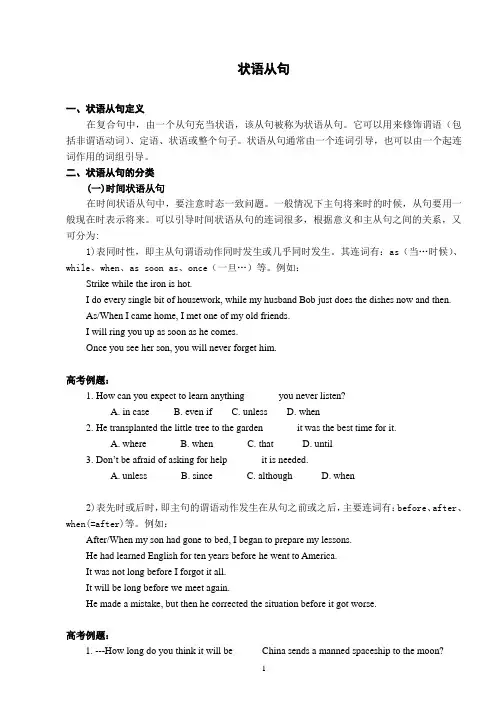
状语从句一、状语从句定义在复合句中,由一个从句充当状语,该从句被称为状语从句。
它可以用来修饰谓语(包括非谓语动词)、定语、状语或整个句子。
状语从句通常由一个连词引导,也可以由一个起连词作用的词组引导。
二、状语从句的分类(一)时间状语从句在时间状语从句中,要注意时态一致问题。
一般情况下主句将来时的时候,从句要用一般现在时表示将来。
可以引导时间状语从句的连词很多,根据意义和主从句之间的关系,又可分为:1)表同时性,即主从句谓语动作同时发生或几乎同时发生。
其连词有:as(当…时候)、while、when、as soon as、once(一旦…)等。
例如:Strike while the iron is hot.I do every single bit of housework, while my husband Bob just does the dishes now and then.As/When I came home, I met one of my old friends.I will ring you up as soon as he comes.Once you see her son, you will never forget him.高考例题:1. How can you expect to learn anything ______ you never listen?A. in caseB. even ifC. unlessD. when2. He transplanted the little tree to the garden ______ it was the best time for it.A. whereB. whenC. thatD. until3. Don’t be afraid of asking for help ______ it is needed.A. unlessB. sinceC. althoughD. when2)表先时或后时,即主句的谓语动作发生在从句之前或之后,主要连词有:before、after、when(=after)等。
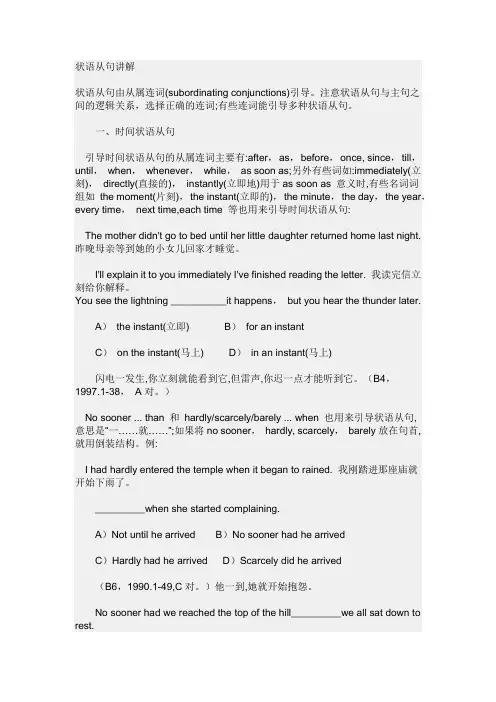
状语从句讲解状语从句由从属连词(subordinating conjunctions)引导。
注意状语从句与主句之间的逻辑关系,选择正确的连词;有些连词能引导多种状语从句。
一、时间状语从句引导时间状语从句的从属连词主要有:after,as,before,once, since,till,until,when,whenever,while,as soon as;另外有些词如:immediately(立刻),directly(直接的),instantly(立即地)用于as soon as 意义时,有些名词词组如the moment(片刻),the instant(立即的),the minute,the day,the year,every time,next time,each time 等也用来引导时间状语从句:The mother didn't go to bed until her little daughter returned home last night. 昨晚母亲等到她的小女儿回家才睡觉。
I'll explain it to you immediately I've finished reading the letter. 我读完信立刻给你解释。
You see the lightning __________it happens,but you hear the thunder later.A)the instant(立即) B)for an instantC)on the instant(马上) D)in an instant(马上)闪电一发生,你立刻就能看到它,但雷声,你迟一点才能听到它。
(B4,1997.1-38,A对。
)No sooner ... than 和hardly/scarcely/barely ... when 也用来引导状语从句,意思是“一……就……”;如果将no sooner,hardly, scarcely,barely放在句首,就用倒装结构。
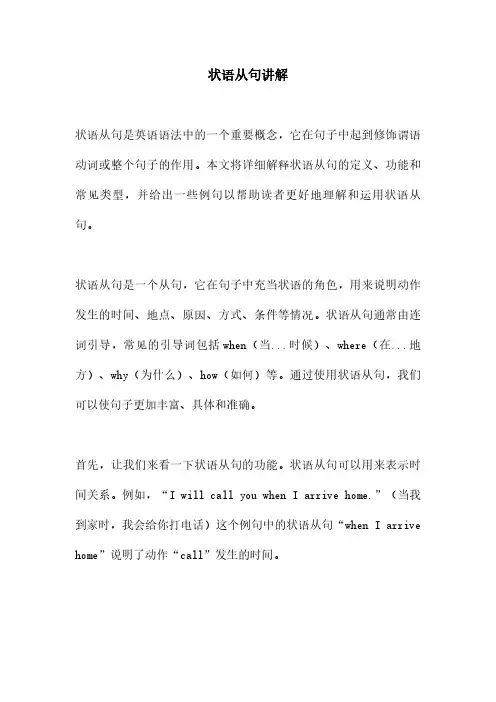
状语从句讲解状语从句是英语语法中的一个重要概念,它在句子中起到修饰谓语动词或整个句子的作用。
本文将详细解释状语从句的定义、功能和常见类型,并给出一些例句以帮助读者更好地理解和运用状语从句。
状语从句是一个从句,它在句子中充当状语的角色,用来说明动作发生的时间、地点、原因、方式、条件等情况。
状语从句通常由连词引导,常见的引导词包括when(当...时候)、where(在...地方)、why(为什么)、how(如何)等。
通过使用状语从句,我们可以使句子更加丰富、具体和准确。
首先,让我们来看一下状语从句的功能。
状语从句可以用来表示时间关系。
例如,“I will call you when I arrive home.”(当我到家时,我会给你打电话)这个例句中的状语从句“when I arrive home”说明了动作“call”发生的时间。
其次,状语从句可以表示地点关系。
例如,“She looked around to see where the noise was coming from.”(她四处看看,想知道声音是从哪里传来的)这个例句中的状语从句“where the noise was coming from”说明了动作“look around”的地点。
此外,状语从句还可以表示原因、条件和方式等关系。
例如,“He couldn't go to the party because he was sick.”(他因为生病所以不能去参加聚会)这个例句中的状语从句“because he was sick”表示了动作“couldn't go”的原因。
在使用状语从句时,需要注意一些语法规则。
首先,状语从句通常放在主句之前或之后,具体位置取决于需要强调的内容。
其次,状语从句的谓语动词通常使用一般现在时,而不受主句的时态影响。
例如,“I will call you when I arrive home.”(当我到家时,我会给你打电话)中的“arrive”使用的是一般现在时。
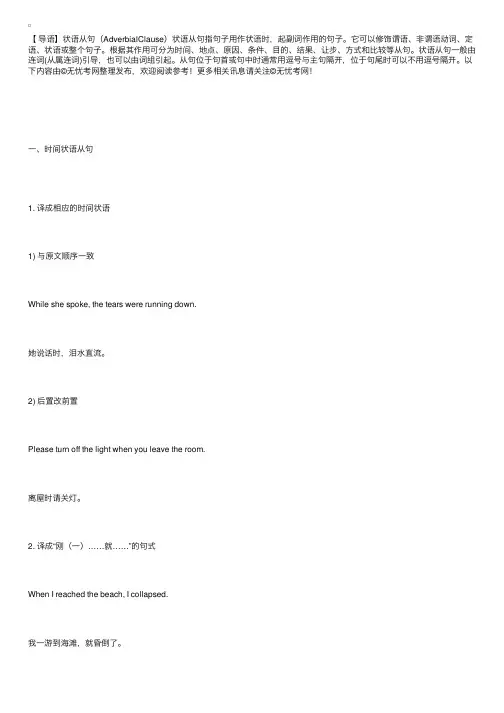
【导语】状语从句(AdverbialClause)状语从句指句⼦⽤作状语时,起副词作⽤的句⼦。
它可以修饰谓语、⾮谓语动词、定语、状语或整个句⼦。
根据其作⽤可分为时间、地点、原因、条件、⽬的、结果、让步、⽅式和⽐较等从句。
状语从句⼀般由连词(从属连词)引导,也可以由词组引起。
从句位于句⾸或句中时通常⽤逗号与主句隔开,位于句尾时可以不⽤逗号隔开。
以下内容由©⽆忧考⽹整理发布,欢迎阅读参考!更多相关讯息请关注©⽆忧考⽹!⼀、时间状语从句1. 译成相应的时间状语1) 与原⽂顺序⼀致While she spoke, the tears were running down.她说话时,泪⽔直流。
2) 后置改前置Please turn off the light when you leave the room.离屋时请关灯。
2. 译成“刚(⼀)……就……”的句式When I reached the beach, I collapsed.我⼀游到海滩,就昏倒了。
3. 译成并列的分句1) 译⽂前置They set him free when his ransom had not yet been paid.他还没有交赎⾦,他们就把他释放了。
2) 后置不变I was about to speak when Mr. Smith cut in.我正想讲,史密斯先⽣就插嘴了。
⼆、原因状语从句1. 译成表“因”的分句1) “因”在“果”之前The crops failed because the season was dry.因为⽓候⼲旱,作物歉收。
2) “果”在“因”之前She could get away with anything, because she looked such a baby.她能渡过任何风险,因为她看上去简直还像娃娃模样。
2. 译成因果偏正复句中的主句Pure iron is not used in industry because it is too soft.纯铁太软,所以不⽤在⼯业上。
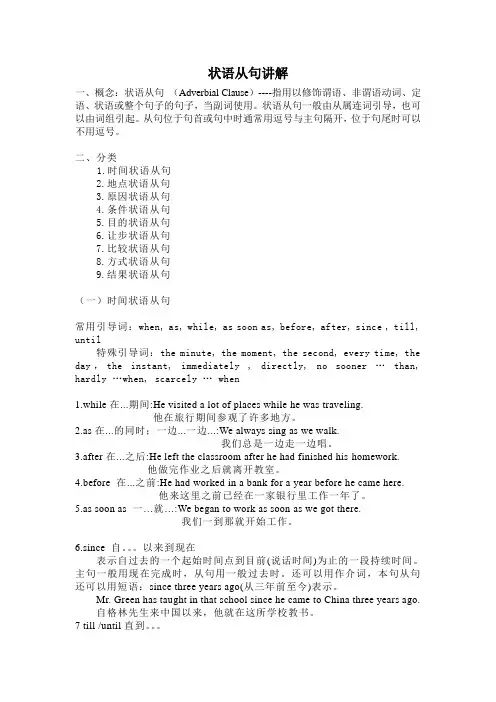
状语从句讲解一、概念:状语从句(Adverbial Clause)----指用以修饰谓语、非谓语动词、定语、状语或整个句子的句子,当副词使用。
状语从句一般由从属连词引导,也可以由词组引起。
从句位于句首或句中时通常用逗号与主句隔开,位于句尾时可以不用逗号。
二、分类1.时间状语从句2.地点状语从句3.原因状语从句4.条件状语从句5.目的状语从句6.让步状语从句7.比较状语从句8.方式状语从句9.结果状语从句(一)时间状语从句常用引导词:when, as, while, as soon as, before, after, since , till, until特殊引导词:the minute, the moment, the second, every time, the day,the instan t, immediately , directly, no sooner … than, hardly …when, scarcely … when1.while在...期间:He visited a lot of places while he was traveling.他在旅行期间参观了许多地方。
2.as在...的同时;一边...一边...:We always sing as we walk.我们总是一边走一边唱。
3.after在...之后:He left the classroom after he had finished his homework.他做完作业之后就离开教室。
4.before 在...之前:He had worked in a bank for a year before he came here.他来这里之前已经在一家银行里工作一年了。
5.as soon as 一…就…:We began to work as soon as we got there.我们一到那就开始工作。
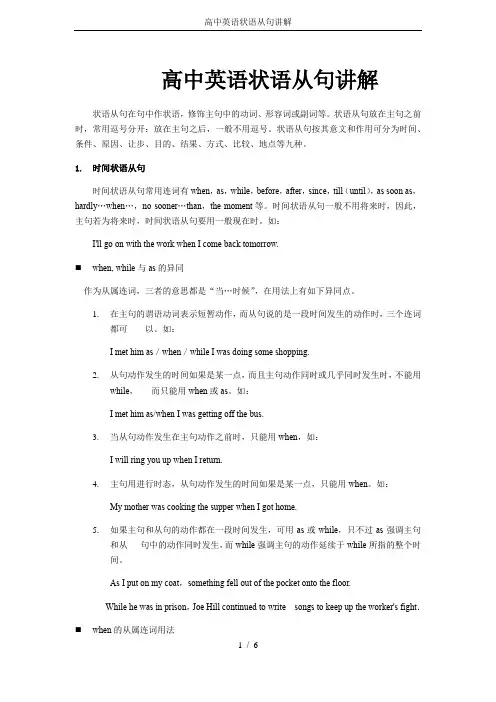
高中英语状语从句讲解状语从句在句中作状语,修饰主句中的动词、形容词或副词等。
状语从句放在主句之前时,常用逗号分开:放在主句之后,一般不用逗号。
状语从句按其意文和作用可分为时间、条件、原因、让步、目的、结果、方式、比较、地点等九种。
1.时间状语从句时间状语从句常用连词有when,as,while,before,after,since,till(until),as soon as,hardly…when…,no sooner…than,the moment等。
时间状语从句一般不用将来时,因此,主句若为将来时,时间状语从句要用一般现在时。
如:I'll go on with the work when I come back tomorrow.⏹when, while与as的异同作为从属连词,三者的意思都是“当…时候”,在用法上有如下异同点。
1.在主句的谓语动词表示短暂动作,而从句说的是一段时间发生的动作时,三个连词都可以。
如:I met him as/when/while I was doing some shopping.2.从句动作发生的时间如果是某一点,而且主句动作同时或几乎同时发生时,不能用while,而只能用when或as。
如:I met him as/when I was getting off the bus.3.当从句动作发生在主句动作之前时,只能用when,如:I will ring you up when I return.4.主句用进行时态,从句动作发生的时间如果是某一点,只能用when。
如:My mother was cooking the supper when I got home.5.如果主句和从句的动作都在一段时间发生,可用as或while,只不过as强调主句和从句中的动作同时发生,而while强调主句的动作延续于while所指的整个时间。
As I put on my coat,something fell out of the pocket onto the floor.While he was in prison,Joe Hill continued to write songs to keep up the worker's fight.⏹when的从属连词用法when作为从属连词引导时间状语从句,既可放在主句之前,也可放在主句之后。
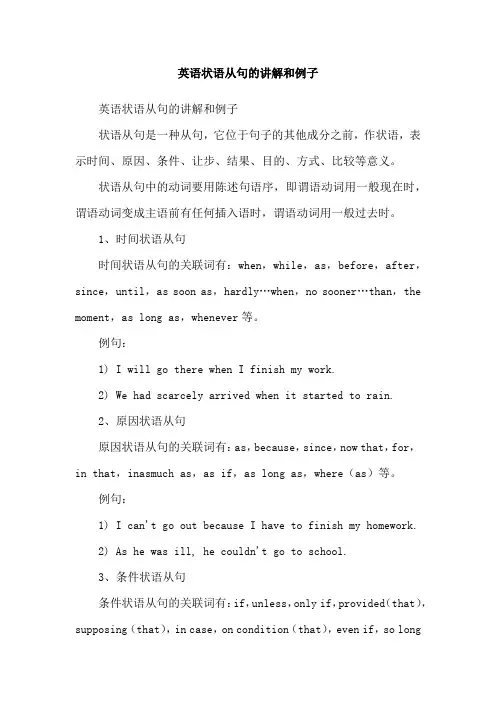
英语状语从句的讲解和例子英语状语从句的讲解和例子状语从句是一种从句,它位于句子的其他成分之前,作状语,表示时间、原因、条件、让步、结果、目的、方式、比较等意义。
状语从句中的动词要用陈述句语序,即谓语动词用一般现在时,谓语动词变成主语前有任何插入语时,谓语动词用一般过去时。
1、时间状语从句时间状语从句的关联词有:when,while,as,before,after,since,until,as soon as,hardly…when,no sooner…than,the moment,as long as,whenever等。
例句:1) I will go there when I finish my work.2) We had scarcely arrived when it started to rain.2、原因状语从句原因状语从句的关联词有:as,because,since,now that,for,in that,inasmuch as,as if,as long as,where(as)等。
例句:1) I can't go out because I have to finish my homework.2) As he was ill, he couldn't go to school.3、条件状语从句条件状语从句的关联词有:if,unless,only if,provided(that),supposing(that),in case,on condition(that),even if,so longas等。
例句:1) If it rains tomorrow, we won't go out.2) I will finish the work even if it takes me all night.4、让步状语从句让步状语从句的关联词有:though,although,while,whereas,no matter(how),whatever,regardless(of)等。
(完整版)状语从句超详细讲解状语从句是复合句的一种,它能够起到修饰主句的作用。
本文将详细讲解状语从句的定义、分类以及使用方法。
定义状语从句是一个修饰、说明主句的从句。
它能够表达时间、地点、原因、条件、目的、方式等等不同的状况或情况。
分类根据状语从句的引导词,我们可以将其分为以下几种类型:1. 时间状语从句:用于表示何时发生或发生过的情况。
常用引导词有:when, while, as, before, after, until, since, as soon as等。
2. 地点状语从句:用于表示事件发生的地点。
常用引导词有:where, wherever。
3. 原因状语从句:用于表示事件的原因。
常用引导词有:because, since, as等。
4. 条件状语从句:用于表示某种条件下发生的情况。
常用引导词有:if, unless, provided that, as long as等。
5. 目的状语从句:用于表示主句中的动作或状态的目的。
常用引导词有:so that, in order that。
6. 方式状语从句:用于表示主句中的动作或状态发生的方式。
常用引导词有:as, as if, as though。
使用方法在使用状语从句时,需要注意以下几点:1. 引导词的选择要准确。
不同类型的状语从句需要选择相应的引导词,以确保表达的准确性。
2. 状语从句的位置可以灵活调整。
可以将状语从句放在主句之前、之后或中间,但要注意语序的调整,以保证句子的通顺。
3. 使用适当的标点符号。
根据句子结构和语义需要,可以在状语从句和主句之间使用逗号、连词等标点符号。
4. 注意主从句的时态和语态一致性。
主句和状语从句之间的动作发生时间要一致,并保持相同的语态。
总结状语从句是一种修饰主句的从句,能够表达时间、地点、原因、条件、目的、方式等不同状况。
根据引导词的不同,状语从句可以分为时间状语从句、地点状语从句、原因状语从句、条件状语从句、目的状语从句和方式状语从句。
状语从句的时间原因条件等用法详细讲解与注意事项状语从句的时间、原因、条件等用法详细讲解与注意事项状语从句是在主句中充当状语的从句,它可以描述时间、原因、条件等多种关系。
掌握状语从句的用法对于提高句子的连贯性和表达的准确性非常重要。
在本文中,我们将详细讲解状语从句在时间、原因和条件方面的常见用法,并提供一些注意事项。
一、时间状语从句时间状语从句用来表示主句发生的时间,它可以使用不同的连词来引导,如when(当...时候)、while(当...的时候)、before(在...之前)、after(在...之后)等。
以下是一些常见的时间状语从句的例子:1. When she arrived, we were already eating dinner.(当她到达时,我们已经在吃晚饭了。
)2. He fell asleep while he was watching TV.(他在看电视的时候睡着了。
)3. I will call you before I leave.(在我离开之前,我会给你打电话。
)4. After I finish this project, I will take a vacation.(在我完成这个项目之后,我会去度假。
)注意事项:- 时间状语从句通常位于主句之前或之后,具体位置可根据上下文需要决定。
- 当主句的时态是一般将来时时,时间状语从句的时态可以使用一般现在时或一般过去时。
二、原因状语从句原因状语从句用来说明主句所表达的动作或情况发生的原因,常由because(因为)、since(因为)、as(因为)等连词引导。
以下是一些常见的原因状语从句的例子:1. We canceled the picnic because of the bad weather.(由于天气不好,我们取消了野餐。
)2. Since you don't have a car, I can give you a ride.(由于你没有车,我可以载你。
状语从句〔一〕状语从句概述〔二〕状语从句详解1. 时间状语从句2.地点状语从句3.条件状语从句4.原因状语从句5.目的状语从句6.结果状语从句7.让步状语从句8. 比拟状语从句9.方式状语从句练习一一. 单项填空1. _______ he’s old, he can still carry this heavy bag.A. ThoughB. SinceC. ForD. So2. ---Do you know if he _______ to play basketball with us"---I think he will e if he ______ free tomorrow.A. es; isB. es; will beC. will e; isD. will e; will be3. In the zoo if a child _____ into the water and can’t swim, the dolphins may e up ______ him.A. will fall; to helpB. falls; to helpC. will fall; helpD. falls; helping4. I don’t remember ________ he worked in that city when he was young.A. whatB. whichC. whereD. who5. We will stay at home if my aunt ________ to visit us tomorrow.A. esB. eC. will eD. is ing6. The police asked the children _______ cross the street ________ the traffic lights turned green.A. not; beforeB. don’t; whenC. not to; untilD. not; after7. I was late for class yesterday _______ there was something wrong with my bike.A. whenB. thatC. untilD. because8. I’ll go swimming with you if I ________ free tomor row.A. will beB. shall beC. amD. was9. In the e*am, the ________ you are, ______ the _______ mistakes you will make.A. careful; littleB. more careful; fewestC. more careful; fewerD. more careful; less10. You should finish your lessons _______ you go out to play.A. beforeB. afterC. whenD. while11. I hurried _____ I wouldn’t be late for class.A. sinceB. so thatC. as ifD. unless12. When you read the book, you’d better make a mark _______ you have any questions.A. whichB. thatC. whereD. though13. The teacher raised his voice _______ all the students could hear him.A. forB. so thatC. becauseD. in order14. He took off his coat _______ he felt hot.A. becauseB. asC. ifD. since15. It is ______ that we’d like to go out for a walk.A. a lovely dayB. too lovely a dayC. so lovely a dayD. such lovely a day16. Mary had ______ much work to do that she stayed at her office all day.A. suchB. soC. tooD. very17. _______ I felt very tired, I tried to finish the work.A. AlthoughB. BecauseC. AsD. As if18. ______ the day went on, the weather got worse.A. WithB. SinceC. WhileD. As19. ______ well you can drive, you must drive carefully.A. So long asB. In order thatC. No matter howD. The moment20. Write to me as soon as you ________ to Beijing.A. will getB. getC. gettingD. got二. 根据中文意思完成以下英语句子1. 不管他跟我开什么玩笑,我都不生气。
状语从句定义:在句中作状语的从句是状语从句,修饰主句中的动词、形容词或副词等。
状语从句由从属连词引导,从属连词在句中不充当句子成分,只起连接作用,状语从句放在句首时,要用逗号,放在句尾时不用。
状语从句主要用来修饰主句或主句的谓语。
一般可分为九大类,分别表示时间、地点、原因、目的、结果、条件、让步、比较和方式。
尽管种类较多,但由于状语从句与汉语结构和用法相似,所以理解和掌握它并不难。
状语从句的关键是要掌握引导不同状语从句的常用连接词和特殊的连接词即考点。
现分别列举如下:一、时间状语从句1.when, while和as的用法(1)when既可引导一个持续动作,也可引导一个短暂性动作.when强调主从句动作的发生有先后。
如:①When he got there, the classroom had been cleaned.他到的时候,教室已打扫过了。
(主句动作发生在从句动作之前)②He went to play football when he finished his homework.做完作业后他就去踢足球了。
(主句的动作发生在从句动作之后)when可作并列连词用,相当于just then,at the time,前一分句多用进行时、be about to或be on the point of doing,表示“正在做..,就在这时发生了另外一件事”或“届时”。
如:①I was reading when he suddenly came in.②I was about to leave when the telephone rang.(2)while强调主句动作发生在从句动作所发生的时间段内,从句的动作必须是延续性动词。
如:①Strike iron while it’s still hot.②Will you please take care of my house while I was away?在这一情况下,从句的动作一定是延续性动词,如果是非延续动词,要用when。